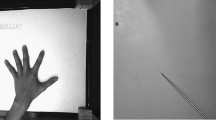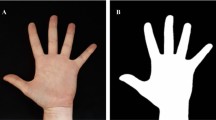Abstract
Previous research has found that the perception of our hands is inaccurate. This distorted representation has several constant characteristics including an overestimation of hand width and an underestimation of finger length. In this study, we further investigate this phenomenon by exploring the boundaries of hand representation. Participants placed one hand underneath a table top so it was occluded from view. Using their free hand, participants were instructed to point to the location where they believed the tips and bases of each of their fingers were. These ten landmarks were recorded using a motion capture system. One group of participants pointed to the landmarks in a random order (as done in previous studies) while another group pointed to them in a systematic fashion (from the tip of the thumb sequentially through to the pinky). Furthermore, to explore if having a frame of reference facilitates hand perception, some participants initiated each of their estimations directly from the previous landmark while others initiated them from a home spot located outside the span of the hand. Results showed that the participants who pointed in the systematic order made numerous accurate judgments of hand size and were overall more precise than participants who pointed in a random order. Including a frame of reference however, had no effect on the judgments. The results also showed asymmetries in hand perception. These findings are discussed in relation to different possible internal body representations and hemispheric asymmetries in body perception.




Similar content being viewed by others
Notes
We also conducted a repeated measures ANOVA using the standard deviation of the five repetitions to each landmark to assess if hand differences were related to the hand employed to point to the landmarks. No significant differences were found between the right and left hands.
References
Bolognini, N., Casanova, D., Maravita, A., & Vallar, G. (2012). Bisecting real and fake body parts: Effects of prism adaptation after right brain damage. Frontiers in Human Neuroscience, 6, 154. doi:10.3389/fnhum.2012.00154.
Brown, S. G., Roy, E. A., Rohr, L. E., & Bryden, P. J. (2006). Using hand performance measures to predict handedness. Laterality, 11(1), 1–14. doi:10.1080/1357650054200000440.
Buchner, H., Kauert, C., & Radermacher, I. (1995). Short-term changes of finger representation at the somatosensory cortex in humans. Neuroscience Letters, 198(1), 57–59.
Cicmil, N., Meyer, A. P., & Stein, J. F. (2015). Tactile Toe Agnosia and Percept of a “Missing Toe” in Healthy Humans. Perception,. doi:10.1177/0301006615607122.
Corey, D. M., Hurley, M. M., & Foundas, A. L. (2001). Right and left handedness defined: A multivariate approach using hand preference and hand performance measures. Neuropsychiatry Neuropsychol Behav Neurol, 14(3), 144–152.
de Vignemont, F., Ehrsson, H. H., & Haggard, P. (2005). Bodily illusions modulate tactile perception. Current Biology, 15(14), 1286–1290. doi:10.1016/j.cub.2005.06.067.
Dijkerman, H. C., & de Haan, E. H. (2007). Somatosensory processes subserving perception and action. Behav Brain Sci, 30(2), 189–201. doi:10.1017/S0140525X07001392. (discussion 201–139).
Farah, M. J., Wilson, K. D., Drain, M., & Tanaka, J. N. (1998). What is “special” about face perception? Psychological Review, 105(3), 482–498.
Gonzalez, C. L. R., & Goodale, M. A. (2009). Hand preference for precision grasping predicts language lateralization. Neuropsychologia, 47(14), 3182–3189. doi:10.1016/j.neuropsychologia.2009.07.019.
Guardia, D., Lafargue, G., Thomas, P., Dodin, V., Cottencin, O., & Luyat, M. (2010). Anticipation of body-scaled action is modified in anorexia nervosa. Neuropsychologia, 48(13), 3961–3966. doi:10.1016/j.neuropsychologia.2010.09.004.
Haggard, P., Kitadono, K., Press, C., & Taylor-Clarke, M. (2006). The brain’s fingers and hands. Experimental Brain Research, 172(1), 94–102. doi:10.1007/s00221-005-0311-8.
Janssen, L., & Steenbergen, B. (2011). Typical and atypical (cerebral palsy) development of unimanual and bimanual grasp planning. Research in Developmental Disabilities, 32(3), 963–971. doi:10.1016/j.ridd.2011.02.002.
Keizer, A., Smeets, M. A., Dijkerman, H. C., Uzunbajakau, S. A., van Elburg, A., & Postma, A. (2013). Too fat to fit through the door: First evidence for disturbed body-scaled action in anorexia nervosa during locomotion. PLoS One, 8(5), e64602. doi:10.1371/journal.pone.0064602.
Linkenauger, S. A., Witt, J. K., Bakdash, J. Z., Stefanucci, J. K., & Proffitt, D. R. (2009). Asymmetrical body perception: A possible role for neural body representations. Psychological Science, 20(11), 1373–1380. doi:10.1111/j.1467-9280.2009.02447.x.
Longo, M. R., & Haggard, P. (2010). An implicit body representation underlying human position sense. Proc Natl Acad Sci USA, 107(26), 11727–11732. doi:10.1073/pnas.1003483107.
Margolis, A. N., & Longo, M. R. (2015). Visual detail about the body modulates tactile localisation biases. Experimental Brain Research, 233(2), 351–358. doi:10.1007/s00221-014-4118-3.
Martuzzi, R., van der Zwaag, W., Farthouat, J., Gruetter, R., & Blanke, O. (2014). Human finger somatotopy in areas 3b, 1, and 2: A 7T fMRI study using a natural stimulus. Human Brain Mapping, 35(1), 213–226. doi:10.1002/hbm.22172.
Napier, J. R. (1980). Hands (1st (American ed.). New York: Pantheon Books.
Neri, P. (2009). Wholes and subparts in visual processing of human agency. Proceedings of the Royal Society of London B: Biological Sciences, 276(1658), 861–869.
Oldfield, R. C. (1971). The assessment and analysis of handedness: The Edinburgh inventory. Neuropsychologia, 9(1), 97–113.
Penfield, W., & Boldrey, E. (1937). Somatic motor and sensory representation in the cerebral cortex of man as studied by electrical stimulation. London; New York: MacMillan.
Porac, C., Coren, S., Steiger, J. H., & Duncan, P. (1980). Human laterality—a multidimensional approach. Canadian Journal of Psychology-Revue Canadienne De Psychologie, 34(1), 91–96. doi:10.1037/H0081015.
Reed, C. L., Stone, V. E., Bozova, S., & Tanaka, J. (2003). The body-inversion effect. Psychological Science, 14(4), 302–308.
Richler, J. J., & Gauthier, I. (2014). A meta-analysis and review of holistic face processing. Psychological Bulletin, 140(5), 1281–1302. doi:10.1037/a0037004.
Saulton, A., Dodds, T. J., Bulthoff, H. H., & de la Rosa, S. (2015). Objects exhibit body model like shape distortions. Experimental Brain Research, 233(5), 1471–1479. doi:10.1007/s00221-015-4221-0.
Seitz, K. (2002). Parts and wholes in person recognition: Developmental trends. Journal of Experimental Child Psychology, 82(4), 367–381.
Shelton, A. L., & McNamara, T. P. (2004). Spatial memory and perspective taking. Mem Cognit, 32(3), 416–426.
Smeets, J. B., & Brenner, E. (2001). Independent movements of the digits in grasping. Experimental Brain Research, 139(1), 92–100.
Soros, P., Knecht, S., Imai, T., Gurtler, S., Lutkenhoner, B., Ringelstein, E. B., & Henningsen, H. (1999). Cortical asymmetries of the human somatosensory hand representation in right- and left-handers. Neuroscience Letters, 271(2), 89–92.
Sposito, A. V., Bolognini, N., Vallar, G., & Maravita, A. (2012). Extension of perceived arm length following tool-use: Clues to plasticity of body metrics. Neuropsychologia, 50(9), 2187–2194. doi:10.1016/j.neuropsychologia.2012.05.022.
Sposito, A. V., Bolognini, N., Vallar, G., Posteraro, L., & Maravita, A. (2010). The spatial encoding of body parts in patients with neglect and neurologically unimpaired participants. Neuropsychologia, 48(1), 334–340. doi:10.1016/j.neuropsychologia.2009.09.026.
Steenhuis, R. E., Bryden, M. P., Schwartz, M., & Lawson, S. (1990). Reliability of Hand Preference Items and Factors. Journal of Clinical and Experimental Neuropsychology, 12(6), 921–930. doi:10.1080/0168863900840103.
Stone, K. D., & Gonzalez, C. L. (2014). Grasping with the eyes of your hands: Hapsis and vision modulate hand preference. Experimental Brain Research, 232(2), 385–393. doi:10.1007/s00221-013-3746-3.
Sutherling, W. W., Levesque, M. F., & Baumgartner, C. (1992). Cortical sensory representation of the human hand: Size of finger regions and nonoverlapping digit somatotopy. Neurology, 42(5), 1020–1028.
Tanaka, J. W., & Farah, M. J. (1993). Parts and wholes in face recognition. Quarterly Journal of Experimental Psychology. A, Human Experimental Psychology, 46(2), 225–245.
Warren, W. H., Jr., & Whang, S. (1987). Visual guidance of walking through apertures: Body-scaled information for affordances. Journal of Experimental Psychology: Human Perception and Performance, 13(3), 371–383.
Wing, A. M., & Fraser, C. (1983). The contribution of the thumb to reaching movements. Quarterly Journal of Experimental Psychology. A, Human Experimental Psychology, 35(Pt 2), 297–309.
Author information
Authors and Affiliations
Corresponding author
Ethics declarations
Funding
This study was funded by a discovery grant awarded to Claudia LR Gonzalez from the Natural Sciences and Engineering Research Council of Canada.
Conflict of interest
The authors declare that they have no conflict of interest.
Ethical approval
All procedures performed in studies involving human participants were in accordance with the ethical standards of the institutional and/or national research committee and with the 1964 Helsinki declaration and its later amendments or comparable ethical standards.
Informed consent
Informed consent was obtained from all individual participants included in the study.
Rights and permissions
About this article
Cite this article
Coelho, L.A., Zaninelli, G. & Gonzalez, C.L.R. A kinematic examination of hand perception. Psychological Research 81, 1224–1231 (2017). https://doi.org/10.1007/s00426-016-0815-9
Received:
Accepted:
Published:
Issue Date:
DOI: https://doi.org/10.1007/s00426-016-0815-9




